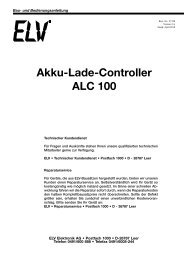Akku-Lade-Center Battery Charging Centre ALC 8500-2 ... - Batimex
Akku-Lade-Center Battery Charging Centre ALC 8500-2 ... - Batimex
Akku-Lade-Center Battery Charging Centre ALC 8500-2 ... - Batimex
Erfolgreiche ePaper selbst erstellen
Machen Sie aus Ihren PDF Publikationen ein blätterbares Flipbook mit unserer einzigartigen Google optimierten e-Paper Software.
1 Introduction<br />
Rechargeable cells, and rechargeable battery packs in particular, are a basic requirement for mobile<br />
equipment, and nowadays they have found their way into virtually all areas of daily life. Today’s consumers<br />
expect mobility, especially in the world of communication, and without suitable rechargeable<br />
energy storage devices this would all be unthinkable, as primary cells (dry cells) are too expensive to<br />
be a viable alternative for many applications. Other areas of activity where nothing “works” without<br />
rechargeable battery systems include a vast range of electric tools - and modelling.<br />
Nickel-Cadmium (NC) and Nickel-Metal-Hydride (NiMH) batteries have always played a dominant role<br />
in this field, and they continue to do so, especially where high discharge currents are required. For<br />
these “high-current” applications the strengths of the old, familiar nickel-cadmium battery are just as<br />
important now as they ever were, as their low internal resistance, shallow discharge curve and fast<br />
charge capability are particularly significant.<br />
For a given cell size, Nickel-Metal-Hydride (NiMH) batteries offer considerably higher capacity, and<br />
they are also much more environmentally friendly since they do not contain cadmium, which is a toxic<br />
heavy metal. All the technical parameters of NiMH cells are being improved constantly, and it seems<br />
inevitable that they will increasingly take over from NC cells in the future.<br />
However, the full performance capability of a rechargeable battery, regardless of the cell technology,<br />
is only maintained if the user cares for it in the appropriate way. Overcharging and deep-discharging<br />
have a particularly damaging effect on the useful life of any energy storage device.<br />
Many electrical devices are supplied as standard with chargers which, for obvious reasons of cost,<br />
are devoid of any “intelligence”, and these crude devices do nothing to extend the useful life of the<br />
batteries with which they are used. The modelling world is not immune to this effect, and the useful<br />
life of our battery packs - some of them extremely expensive - is greatly reduced if unsuitable charging<br />
methods are employed. Often this results in a pack which only delivers a fraction of the maximum<br />
possible number of charge / discharge cycles. When you bear these aspects in mind, the cost of a<br />
sophisticated, efficient battery charger is quickly recouped.<br />
1.1 The essential performance features of the <strong>ALC</strong> <strong>8500</strong>-2 Expert<br />
The <strong>ALC</strong> <strong>8500</strong>-2 Expert is an absolute top-notch device in terms of battery charging technology, and<br />
includes performance features offered by no other charger. It provides four charge channels, operating<br />
independently of each other, and capable of carrying out entirely different functions simultaneously. The<br />
charger’s comprehensive range of functions and program sequences are supported by a large, backlit<br />
graphic screen, and the unit is easy to operate thanks to the inclusion of a jog dial and a straightforward<br />
menu system.<br />
The <strong>ALC</strong> <strong>8500</strong>-2 Expert supports all the most important battery technologies, including Nickel-Cadmium<br />
(NC), Nickel-Metal-Hydride (NiMH), Lead-Gel, Lead-Acid, Lithium-Ion (Li-Ion) and Lithium-Polymer (LiPo).<br />
The firmware of the forward-looking <strong>ALC</strong> <strong>8500</strong>-2 Expert can be updated at any time due to the use of<br />
flash memory. This means that the software can be expanded and the charger updated to cope with<br />
new or changing battery technologies.<br />
The <strong>ALC</strong> <strong>8500</strong>-2 Expert features four separate charge outputs to which rechargeable cells or batteries<br />
can be connected simultaneously; the generously rated mains power supply allows all four channels to<br />
operate at the same time.<br />
Charge channels 1 and 2 are designed for battery packs containing up to twenty series-wired cells, and<br />
each can deliver a charge current of up to 5 A (according to the cell count; see Table 1). To reduce the<br />
waste heat, secondary pulsed switching regulators are used in this section.<br />
Charge channels 3 and 4 are designed for batteries with a nominal capacity of up to 12 V (10 cells); the<br />
total rated charge current can be divided up over these two channels in any way you wish.<br />
The charger also features a battery database in which you can store charge parameters for individual<br />
batteries; these parameters can then be called up again at any time. When you wish to charge cells or<br />
batteries whose data has already been stored, the charger simply uses that data for its processing,<br />
eliminating the need to set the charge parameters all over again. The <strong>ALC</strong> <strong>8500</strong>-2 Expert also incorporates<br />
an integral data logger which records complete charge / discharge cycles without the need to have<br />
32



